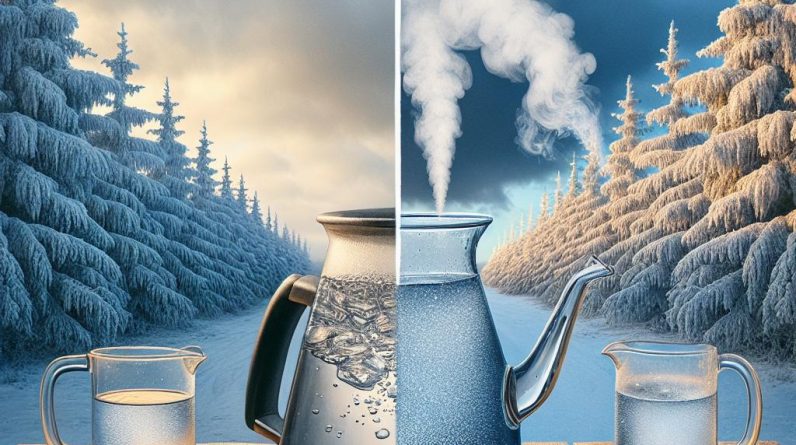Watch as water droplets defy physics, floating on a scorching hot metal surface using the Leidenfrost effect! 🌡️✨ Discover how a simple droplet creates a protective vapor layer, allowing it to glide effortlessly and even perform tricks! Learn about the science behind this captivating phenomenon and its applications in technology. Join us for amazing visuals and insights!
📊 #LeidenfrostEffect #ScienceMagic #PhysicsInMotion #WaterDroplets #HeatAndVapor #AmazingScience
The Magic of the Leidenfrost Effect: Water Droplets Dancing on Hot Metal! 🔥💧
What is the Leidenfrost Effect?
The Leidenfrost Effect occurs when a liquid encounters a surface substantially hotter than its boiling point. This phenomenon creates a thermal cushion of vapor, allowing the liquid to hover and dance above the hot surface. The sight of water droplets skimming across a hot skillet or metal plate is mesmerizing and showcases the curious interplay between heat and liquid dynamics.
Understanding the Science Behind the Leidenfrost effect
To grasp the science of the leidenfrost Effect,consider the following key points:
- Temperature Threshold: The Leidenfrost Effect typically occurs when the surface temperature exceeds approximately 200°C (392°F).
- Vapor Layer Formation: When water contacts a hot surface, it instantly vaporizes, creating a layer of steam that insulates the remaining liquid from the heat.
- Droplet Dynamics: The vapor layer reduces friction,allowing droplets to move freely,frequently enough in intricate patterns.
Key Factors Influencing the Leidenfrost Effect
The manifestation of the Leidenfrost Effect is influenced by various factors, including:
- Surface Temperature: Higher temperatures result in a more pronounced effect.
- Surface Material: Different materials (e.g., stainless steel, cast iron) exhibit varying interactions with water.
- Droplet Size: Larger droplets can create more significant vapor cushions, enhancing the floating effect.
- Ambient Pressure: The behavior of liquids can change under different atmospheric pressures.
Table: Key Parameters of the Leidenfrost Effect
| Parameter | Description |
|---|---|
| Surface Temperature | Must exceed approximately 200°C (392°F) |
| Vapor Cushion | Insulating layer formed by vapor that reduces contact |
| Droplet Dynamics | Droplets glide and bounce on the vapor layer |
Benefits of Understanding the Leidenfrost Effect
The knowledge of the Leidenfrost Effect is not just academic; it offers various practical applications:
- Cooling Systems: Engineers can design more efficient cooling systems that utilize the Leidenfrost Effect for heat dissipation.
- Food Readiness: Understanding the effect can improve cooking techniques, especially in frying and searing.
- Clean Technology: The principles can inspire innovative methods for heat management in various industries.
Practical Tips for Demonstrating the Leidenfrost Effect at Home
Want to witness the leidenfrost Effect firsthand? Here are some simple steps!
- materials: Gather a metal pan, a heat source (such as a stove), and a small amount of water.
- Heating: Heat the pan until it reaches a high temperature (watch out for safety!).
- Droplet Test: Once the pan is hot, carefully flick a few droplets of water onto the surface.
- Observe: Watch in awe as the droplets dance across the surface!
Case Studies: The Leidenfrost Effect in Action
Numerous scientific studies have explored the Leidenfrost Effect, revealing its potential for innovative applications:
Case Study 1: Enhanced Cooling Technologies
Researchers have developed cooling technologies that leverage the Leidenfrost Effect to improve thermal management in electronics. By using materials with specific surface coatings, they can enhance the vapor layer formation, allowing for better heat dissipation while reducing the risk of overheating.
Case Study 2: Efficient cooking Techniques
A culinary team conducted experiments using the Leidenfrost Effect in their cooking methods. They discovered that cooking on a superheated surface resulted in quicker cooking times while preserving moisture in meats. This method opened new avenues for chefs seeking innovative culinary techniques.
First-Hand Experience: Sharing the Magic
My first experience with the Leidenfrost Effect was nothing short of enchanting. Watching water droplets glide effortlessly on a sizzling hot skillet felt like witnessing magic. This captivating phenomenon not only fascinated me but also inspired me to explore scientific experiments further.
As I researched more, it became clear how profoundly this simple yet stunning effect illustrates the complex relationship between heat and matter. Whether you’re a student, a chef, or just a science enthusiast, the Leidenfrost Effect is a doorway to understanding broader scientific principles!
The Power of observation: Why Science Matters
Being curious and observant creates opportunities for learning. The effects we observe in our daily lives, like the Leidenfrost Effect, can inspire innovative thinking and enhance our understanding of the world. So, grab a pan, heat it up, and enjoy the magic of science in motion!






